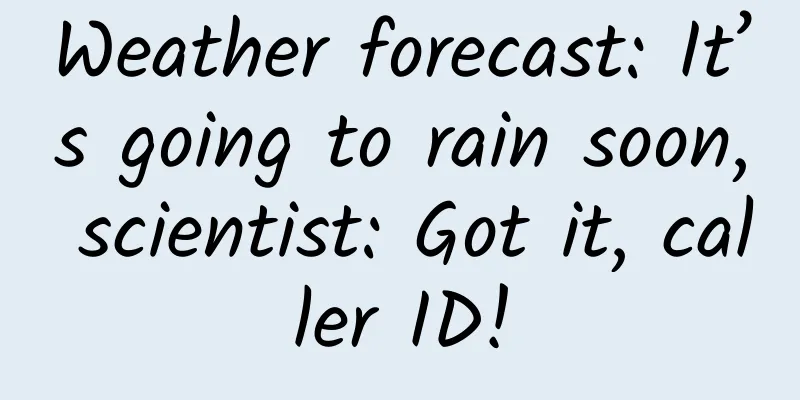Weather forecast: It’s going to rain soon, scientist: Got it, caller ID!

|
Produced by: Science Popularization China Author: Cheng Mingchen (popular science creator) Producer: China Science Expo "The wind sneaks into the night, moistening everything silently." Rain, as an indispensable part of the water cycle in nature, nourishes all things in the world. But sometimes, continuous rainy days can also bring us troubles - the downpour causes the water level of reservoirs, rivers, and lakes to surge, and even cause floods. Water can carry a boat, but it can also overturn it. The two-sided nature of rain inevitably has a huge impact on our lives. However, when the summer rainstorm pours down with devastating force, have you ever thought that the raindrops also have considerable energy hidden in them? In fact, some people have been trying to generate electricity from rainpower for a long time and have achieved certain results . Perhaps in the near future, we will also be able to use electricity generated by rainpower. Let us learn about the different attempts of scientific researchers in the field of rainpower. Cherrapunji, India: Known as the "rainiest place in the world" (Image source: easternvoyages) Micro hydroelectric power station on the roof How can rainwater be used to generate electricity? In essence, there is no difference between rainwater and water in rivers, so the most straightforward method is to first store a large amount of this "rootless water" in high places such as roofs, and then use the principle of hydropower generation to convert the gravitational potential energy of rainwater into electrical energy. The theory is simple, but is it feasible in practice? Let's switch our perspective to Mexico, one of the most water-scarce countries in the world, with more than 10 million people without access to tap water. Even in the capital, Mexico City, nearly 250,000 people still live with water shortages. Therefore, many families install water collection pipes under their eaves to collect rainwater for use, but the severe air pollution in the area causes the rainwater to be mixed with a large amount of impurities and pollutants. In order to solve the problem of rainwater purification and power generation at the same time, in 2014, three students from the Polytechnic University of Mexico, Omar, Romel and Gustavo, came up with an interesting idea. They applied rain power generation to reality and created a rain power generation system called "Pluvia". Three students invented the Pluvia rain power system (Image source: NewAtlas) They designed a section of pipe with a micro-turbine connected to the entrance of the top of the water tank. After the rainwater from the roof is collected through the funnel, it will flow down the pipe equipped with a charcoal filter, then drive the micro-turbine, and finally enter the underground water tank. The rotation of the turbine will drive the generator and charge the 12-volt battery. Part of the electricity is used to drive the water purifier. The treated water is cleaner than the city water supply. The system has been tested in the Iztapalapa community in Mexico City, and students are now looking to increase power generation and storage capacity to help more households alleviate water and electricity problems in the future. Conceptual image of the rainwater power generation system (this image is not the work of the three students) (Image source: spectrum) The three students are worthy of encouragement for their innovation and for transforming the theories on paper into practical products that benefit local residents. However, due to the huge limitations of this energy conversion method itself, there is no doubt that the efficiency of this form of rainwater power generation is too low and there is very limited room for improvement. Adding a "generator" to raindrops Traditional forms of power generation cannot be separated from generators, but each discrete raindrop has only tiny amounts of energy and cannot provide continuous power. Therefore, in order to collect the energy of rainwater and improve the efficiency of rainpower generation, a special type of "generator" is needed. Among them, piezoelectric material is a material that is covered with countless "tiny generators". It does not use electromagnetic induction to generate electricity, but uses the special arrangement of its own atoms to directly convert the deformation caused by force into electric charge. The origin of piezoelectric materials is quite dramatic. In 1880, French physicist Pierre Curie (husband of the famous Madame Curie) and his brother Jacques Curie discovered piezoelectric materials in the laboratory. They noticed that when a quartz crystal was under heavy pressure, a small amount of electric charge was generated on part of its surface. Since then, piezoelectric materials have been widely used. There is a piece of piezoelectric material hidden in the ignition device of lighters and gas stoves. The "power generation floor" laid at crowded stations or intersections also generates electricity through piezoelectric materials. A piezoelectric floor path in London (Image source: inhabitat) In 2008, Leti, a technology research and development institute under the French Atomic Energy Commission (CEA), whose main research and development areas are micro-nanotechnology and applications, published a study in the journal Smart Materials and Structures. Romain Guigon introduced their team's method of using piezoelectric materials to obtain energy from raindrops. Left: Test bench for rain power generation Right: Piezoelectric material at the bottom of the test bench (Image source: Smart Materials and Structures) When raindrops fall on the ground, they will experience inelastic impact collisions. During this process, the breakage, splashing, vibration, and viscoelastic deformation of raindrops will cause energy loss. Researchers have improved the "raindrop collision model" and roughly estimated the amount of usable energy in raindrops. In order to capture the mechanical energy generated by this part of the impact, these scientists used a piezoelectric material called PVDF (polyethylene fluoride) polymer to successfully convert the kinetic energy of raindrops directly into electrical energy. By simulating raindrops with different falling speeds, they also found an interesting pattern: slowly falling raindrops tend to generate more electricity, which may be due to the fact that high-speed raindrops are more likely to splash. In addition, by observing raindrops with diameters ranging from 1 to 5 mm, they found that the available energy of each raindrop ranged from 1 to 10 mJ, and raindrops in "heavy rain" had a power generation capacity of up to 12 mW. However, even so, it still cannot meet the requirements of mobile phone charging - the power required for slow charging of mobile phones is 5W, that is, at least equivalent to 5,000 large raindrops falling at the same time. In recent years, other scholars have also adopted similar ideas to carry out more in-depth research, fully confirming the feasibility of using piezoelectric materials for rain power generation, but the power generation efficiency has not been broken through (no more than 0.12%). The process of raindrops colliding with the ground (Image source: Energy, translated by the author) In a sense, rain power is already a reality? The weather is unpredictable. The wind, rain, thunder and lightning of nature contain huge energy. At present, due to the limitation of technical conditions, we can only use part of the energy of wind. But in fact, the "rain power" in this process is not completely wasted. Precipitation is often accompanied by strong winds, and wind, as a carrier of raindrops, has already achieved a certain degree of rain power generation. The output power of wind turbines is closely related to the air in front of them, and the density of air mixed with rainwater will increase slightly. In theory, wind turbines will generate more electricity on rainy days (although only a little bit). In addition, rainwater can also wash away the dust and stains attached to the surface of the blades, improving the aerodynamic performance of the originally dirty blades. Therefore, the electricity we use in our daily lives already indirectly includes "rain electricity", rather than "rain has nothing to do with me". There is still a long way to go in the application of rain power generation, and there will be wind and rain on this road, but we believe that with the unremitting efforts of generations, the silent raindrops will eventually provide us with more electricity. Wind turbines in the rain (Photo source: fineartamerica) References: [1]Ben Coxworth. Rainwater used to generate electricity [2]Guigon, Romain, Chaillout, Jean-Jacques, Jager, Thomas, and Despesse Ghislain. Harvesting raindrop energy: theory and Harvesting raindrop energy: an experimental study. Smart Mater. Struct. 17 (2008) 015038-9. [3]Ilyas, MA, & Swingler, J. (2015). Piezoelectric energy harvesting from raindrop impacts. Energy, 90, 796–806. doi:10.1016/j.energy.2015.07.114 [4]Xu, W., Zheng, H., Liu, Y. et al. A droplet-based electricity generator with high instantaneous power density. Nature 578, 392–396 (2020). [5]F.-R. Fan, et al., Flexible triboelectric generator, Nano Energy (2012), doi:10.1016/j.nanoen.2012.01.004 Editor: Sun Chenyu |
<<: Ten years of hard work? The first manned flight of the Starliner spacecraft is delayed again
Recommend
Summary of New Consumer Brands’ Breakthrough in 2021
Breaking the impasse: We must coordinate with the...
43 apps including WeChat, Alipay, and Douyin will undergo "aging-friendly" transformation
[[360191]] According to domestic media reports, L...
A woman got blisters on her skin during an MRI exam, just because she was wearing a pair of nice yoga pants?
Wearing yoga pants can help you burn fat as long ...
How to use the five major features of QQ promotion to carry out online marketing?
Many marketing and promotion personnel will use Q...
Building an e-commerce product center from 0 to 1
This series of articles will introduce the produc...
Little-known facts about teeth cleaning | 90% of people don’t know!!
After teeth cleaning, my gums are red, swollen an...
Seeing too much, China's Sky Eye poses a problem for scientists
"The main challenge facing the China Sky Eye...
Economy in physics: What is the principle of least action?
Today I will tell you about an economic principle...
How to learn planning and development projects?
The planners I have seen, whether they are from t...
Porsche also exposed the exhaust scandal. German manufacturing is no longer trusted.
I believe that friends who like cars have already...
How to promote marketing on Weibo? Take the industry's high-quality cases~
This article starts from social media marketing ,...
iOS Development - Do you really know how to use SDWebImage?
[[166005]] SDWebImage is currently the most popul...
New energy vehicles have received subsidies of 19 billion yuan in the past two years, with Yutong, BYD and JAC being the top beneficiaries
Recently, the Ministry of Industry and Informatio...
How can Alibaba's Double 11, which makes you confused, hit 150 billion yuan?
In 2009, Tmall (then known as Taobao Mall) began ...
The value of the Randeng seovip private school system course is 3580 yuan
The course comes from the official website of the...









